Service dog

| Disability |
|---|
|
Theory and models |
|
Therapy |
|
Societal implications |
|
A service dog is a term used in the USA to refer to any type of assistance dog specifically trained to help people who have disabilities, such as visual impairment, hearing impairments, mental disorders (such as post traumatic stress disorder), seizures, mobility impairment, and diabetes.
Outside the USA the term service dog means a dog who works for police, military or search and rescue services, while the term 'assistance dog' is the legal term for a dog which is trained to provide assistance and support for a disabled person.[1] Service dogs can be found in a wide range of settings, and include well known examples such as police dogs and search and rescue dogs. Following the Grenfell Tower Fire in London, service dogs were relied on heavily in the detection of combustible material and the bodies of the deceased.[2]
Desirable character traits in service animals typically include good temperament or psychological make-up (including biddability and trainability) and good health (including physical structure and stamina). Some service dogs are bred and trained by service dog organizations, while others are bred by breeders, and trained by private trainers or even the individuals with disabilities who will someday become their partners. Labrador Retrievers, Golden Retrievers, Labrador Retriever/Golden Retriever crossbred dogs, and German Shepherd Dogs are among the most common dog breeds working as service dogs today in the United States. Although dogs of almost any breed or mix of breeds may be capable of becoming a service dog, very few dogs have the requisite health and temperament qualities. Such a dog may be called a "service dog" or an "assistance dog", the terminology typically varying by country or region. The term "seeing eye dog" is frequently used as a generic label referring to any dog assisting individuals who are blind or have visual impairments and typically seen wearing green AAAM (Assistant Animals of America) vests.
History
During the First World War, the German army relied heavily on the use of German Shepherds as ambulance and messenger dogs. Schools helped to train the German Shepherds to serve as guides. German doctor Gerhard Stalling opened the world’s first guide dog school in 1916.[3] World War II helped lead to a major increase in the number of guide dog schools in the United States. The guide dogs that were used by veterans in the United States are linked to the original training schools set up in Germany to care for World War I veterans.[4]
First Schools

Hearing Dogs for Deaf People, launched in 1982, train dogs to alert their hearing impaired or deaf owners to a number of specific sounds by touching their owner’s foot with a paw, or nudging them with their nose.[5] Dogs For the Disabled, founded in 1988, were the first charity in the UK to train mobility assistance dogs for physically disabled adults.[5]
Organizations within Assistance Dogs UK also collaborate to train dogs in multiple assistance roles for individuals with more than one disability began in 2003.[5] Mobility assistance dogs are defined as ‘Service dogs’ by Assistance Dogs International in 2013.[5]
In addition to the typical canine qualities of loyalty, affection, and devotion, they were looking for dogs that were particularly keen, alert, and eager to learn.[6]
United States
Definition

In the United States, the applicable law covering places of public accommodation is Title III of the Americans with Disabilities Act of 1990 (ADA).[7]
On September 15, 2010, the United States Department of Justice, Civil Rights Division, Disability Rights Section, issued new and updated regulations regarding Service Animals, as summarized in its official guidance document, which states:
"Service animals are defined as dogs that are individually trained to do work or perform tasks for people with disabilities. Examples of such work or tasks include guiding people who are blind, alerting people who are deaf, pulling a wheelchair, alerting and protecting a person who is having a seizure, reminding a person with mental illness to take prescribed medications, calming a person with Post Traumatic Stress Disorder (PTSD) during an anxiety attack, or performing other duties. Service animals are working animals, not pets. The work or task a dog has been trained to provide must be directly related to the person's disability. Dogs whose sole function is to provide comfort or emotional support do not qualify as service animals under the ADA."[8]
The revised definition of service animal specifically excludes animals whose sole function is to provide comfort or emotional support, and states that, "beginning on March 15, 2011, only dogs are recognized as service animals under titles II and III of the ADA."[9] There may be state laws giving broader protections to individuals with disabilities in places of public access (eg: criminal fines or penalties for injury of a service animal); if a situation arises in which one law gives lesser or greater protections to applicable individuals, the law giving the most protection to those individuals is applicable.
Common tasks for service animals include flipping light switches for someone who lacks the dexterity to do so, picking up dropped objects a human partner cannot reach due to a disability, avoiding obstacles for an individual who is blind or visually impaired, alerting someone who is deaf or hard of hearing to the sound of an alarm clock, assisting someone with a psychiatric disability by providing specifically-trained forms of deep-pressure therapy or interrupting repetitive behaviors (such as might occur in Obsessive-Compulsive Disorder), or similar disability-related tasks.[10] While any service dog may provide comfort or emotional support to a disabled human partner, in order to meet the federal definition of a service dog, a dog must also be trained to perform tasks or to do work which are directly related to the dog's partner's disability.
Service dogs are capable of assisting individuals with autism. The dogs are taught to calm down their owners when they are having an attack or breakdown. The dogs are also there to comfort their owners when they get upset and act as a social support system. It is common for an individual with autism to try to run away from home. If that happens, the service dog is capable of alerting the parents, then locating the individual. The service dog can help prevent their owners from running into traffic or getting into other types of dangerous situations.[11]
Service dogs do not only help owners with disabilities, but they also help emotionally. Experiments have demonstrated that service dog owners experience an improved social life while owning a service dog. This is very important when discussing children that own service dogs. Improving someone’s social life includes more friendly glances/conversations and more smiles directed their way.[12]
While the ADA has narrowed the definition of service animals that are required to be permitted in places of public accommodation, other federal laws continue to provide broader definitions in other areas. For instance, the Department of Transportation's regulations enacting the Air Carrier Access Act permit "dogs and other service animals" to accompany passengers on commercial airlines.[13] The Fair Housing Act also requires housing providers to permit service animals (including comfort and emotional support animals) without species restrictions in housing.[14]
There is no federal certification of service animals in the United States. Any company, website, or person saying they are/represent the "official United States service animal registry" or the "official ADA registry" are scammers out to a) take money from the disabled b) take money from people who illegally wish to take their pet in non-pet friendly places (an act which greatly endangers both the lives and legitimacy of real disabled handler/service dog teams). This means employees and staff of places of public access are restricted in the questions they may ask an individual who is accompanied by a service dog. If it is not already obvious what service a particular dog is providing his or her human partner:
Staff may ask two questions: (1) is the dog a service animal required because of a disability; and (2) what work or task has the dog been trained to perform? Staff cannot ask about the person's disability, require medical documentation, require a special identification card or training documentation for the dog, or ask that the dog demonstrate its ability to perform the work or task.[9]
Public
Under the ADA, individuals with disabilities who use service dogs are granted legal access to be accompanied by their service dogs in all places of public accommodation. Under Title II, the ADA prohibits discrimination against people with disabilities by public entities.[15]
Public access rights of owners, handlers, and partners of service dogs vary by country. In the United States, ADA guidance states:
State and local governments, businesses, and nonprofit organizations that serve the public generally must allow service animals to accompany people with disabilities in all areas of the facility where the public is normally allowed to go. For example, in a hospital it would be inappropriate to exclude a service animal from areas such as patient rooms, clinics, cafeterias, or examination rooms. However, it may be appropriate to exclude a service animal from operating rooms or burn units where the animal’s presence may compromise a sterile environment."[9]
Schools
Service dogs are accommodated for individuals who have a disability. ADA requires schools to permit the use of service dogs, but it doesn’t require the schools to supervise service dogs. Students should be responsible for their own dog if it is disruptive.[16] In schools, service dogs may help with performing tasks, or trained for individuals with social phobias.[17]
Under the Fair Housing Act, a service dog is allowed in campus housing if it meets the following criteria:
- The dogs handler is disabled
- The dog is trained to perform tasks for the individual to mitigate/ease their disability
- The handler has documentation of their need for their service dog
The following aren’t permitted as a service dog on campuses:
- Animals other than dogs (miniature horses can be trained to be service animals and would therefore be allowed access the same as a service dog)
- Emotional support dogs/pets (some campuses allow)
Disabled owners, handlers, and partners of service dogs are protected under the Americans with Disabilities Act of 1990,[18] (ADA) which generally gives them the right to be accompanied by their service animal anywhere the general public is allowed. Additional federal laws protect people with disabilities partnered with service animals, as well as other types of assistance animals, from discrimination in housing (the Fair Housing Amendments Act)[19] and on aircraft (the Air Carrier Access Act).[20]
Although the ADA grants individuals with disabilities accompanied by service dogs the right to access almost all places of public accommodation where the general public is permitted,[21] individuals accompanied by emotional support animals are not granted the same protections.
Under the ADA, a place of public accommodation may require an individual accompanied by a service dog to remove the service dog from its premises under particular circumstances, one example being if "a service animal is out of control and the handler does not take effective action to control it."[21] Individuals may also be asked to remove their service dogs from, or disallow the presence of a service dog entirely, if the presence of the animal constitutes a fundamental alteration of the business or poses a direct threat. Persons with service dogs are not required to pay any additional fees on account of the service dog, though the owner is responsible for any damages caused by the dog.[22]
Appearance
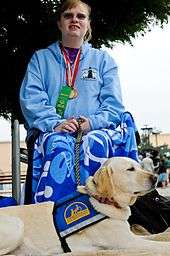
Service dogs may be identified by an optional harness, backpack, vest, bandana, or labelled leash, which may sometimes be colored to indicate the type of service dog.[23]
Breeds
A recent study found that 4 particular dog breeds were especially successful in becoming service dogs. Labrador Retrievers, Golden Retrievers, Labrador/Golden Retriever crosses, and German Shepherds were found to be most likely to graduate training and become service animals. The study found that the Labrador/Golden Retriever crosses and Labrador Retrievers were the most successful when in training for a shorter period of time, while German Shepherds and Golden Retrievers were most successful if they were trained for longer than a 4-month period. Small dogs are also widely used as service dogs. They are not able to guide or pull, but they are able to be medical alert or PSD dogs.[24]
Small Dogs
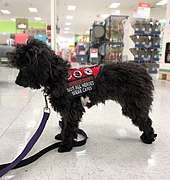
Small dogs are being widely used for those with invisible disabilities. These dogs are less expensive to own, travel easier and are found to give more medical alerts. Small service dogs go through just as much training as any large dog does. However, more access issues and problems from the public arise with these dogs. Many people do not understand what a small dog is able to do.
Nutrition
In order for service and working guide dogs to continue to stay healthy and provide assistance to their handlers, they must maintain a healthy lifestyle with good nutrition and exercise. This means that dogs such as sprinting dogs would require protein, fat, and good carbohydrate diet to maintain energy for playing and helping others. Dogs such as hunting or patrol dogs (like Labradors and German Shepherds) need higher levels of fat in their diets because of the energy expended while walking or working with people in need as well as playing.[25]
Housing
The Americans with Disabilities Act also applies to co-ops and condominiums.[26][27] In cases brought under the civil provisions of the ADA, prevailing plaintiffs are entitled to recover their attorneys' fees; hundreds of lawsuits have been brought based on ADA violations.[26]
In New York, the New York City Human Rights Law administered by the New York City Commission on Human Rights (CCHR) provides further parallel protection with regard to violations in this regard by landlords and management of co-ops and condominiums, despite a building's policy of no-pets at all or no-pets in certain locations.[27] Furthermore, the City of New York states that:
"All service dogs in New York City must have a valid dog license issued by the City's Department of Health. You may also request ... a tag that identifies your dog as a service dog. The tag is optional and businesses open to the public, including restaurants, must allow access to a service dog whether or not the dog is wearing a service tag. You must meet certain requirements to obtain the tag. Businesses may not demand any proof of disability or certification of the animal to allow a person to access the business with their service animal."[28]
Litigation
In 2009, New York City paid a 65-year-old woman $10,000 to settle a federal lawsuit which claimed it had violated the ADA by denying the woman with her service dog access to transportation with the dog.[29] Two New York City policemen had given her a ticket for bringing her dog into a subway station.[29]
In 2013, a Brooklyn Federal Court judge ordered the MTA to pay a 70-year-old Manhattan woman $150,000 to settle a lawsuit concerning her service animal. The judge ruled that the MTA had violated the ADA when its drivers, motormen, and conductors denied the woman access to transportation with her dog, or improperly demanded to see its papers.[30]
In May 2014, federal United States District Court Judge Robert N. Scola, Jr. called it "absurd" and "unreasonable"[31] when a condominium association did not allow a disabled resident to keep a service dog because the dog violated the condo's rules. The condominium settled with the condo resident for $300,000.[32]
In the year ending June 30, 2014, there were 1,939 lawsuits in the United States for ADA violations, up 55% from the previous year.[33]
In December 2014, in conjunction with a federal lawsuit in San Francisco against Uber for it not allowing riders to take service dogs in Uber cars, the United States Department of Justice ruled that Uber was required to do so under the ADA.[34]
In March 2015, a San Antonio jury awarded a service dog owner $29,000 after finding that his employer, a subsidiary of Schlumberger, violated the Americans with Disabilities Act.[35] The employer had denied the dog owner's request that he bring his service dog to work.[35][36][37]
Fake Service Dogs
There have been reports of people fraudulently passing off their untrained, ordinary pets as service dogs by purchasing service dog vests and other accessories from online companies, prompting law enforcement agencies to investigate and penalize the perpetrators.[38] An individual can only legally ask two certain questions to determine if a person has a service dog: whether the dog is a service animal required because of a disability and what work or task the dog has been trained to perform.[39]
As of October 2017, 19 states have passed laws that prohibit the misrepresentation of an untrained animal as a service dog.[40]
Taxes
People who have service animals are permitted to deduct (as part of medical expenses if medical expenses are deducted) the expenses related to buying, training, and maintaining a service dog or other animal.[41][42][43] This includes expenses for food, grooming, and veterinary care.[41][42] This permission is limited to service animals for people with visual impairments, hearing impairments, or another physical disability.[41]
United Kingdom
Summary
The first recorded school to train guide dogs was established in Germany in 1918 after the first world war, and the first training school in the UK.[5]
Assistance dogs within the UK include guide dogs, hearing dogs, mobility assistance dogs, and dual-purpose dogs. Most of the first schools for training guide dogs were established in the United Kingdom.[5]
Japan
Summary
The Service Dogs Access Law was established in the country of Japan in 2002. In the years from 2000-2015, the presence of service dogs in Japan increased with the establishment of the Service Dogs Access Law.[44]
Training
.jpg)
A service dog is a dog that performs a task that mitigates a disability of the dog's owner. Since each person experiences a disability differently and therefore has different needs for assistance, each dog is to some extent custom-trained for the individual it will help.
Dogs were first trained to be service dogs during periods after war to help soldiers who had suffered disorders or disabilities like post traumatic stress disorder (PTSD). Dogs were also trained to help soldiers in combat. Early service dogs received training for two years, and during those two years between $25,000 and $50,000 was expended for just one dog.[45]
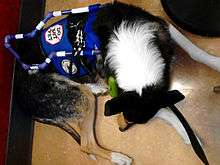
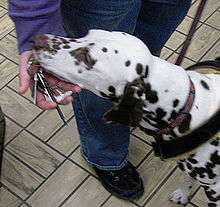
Trainers
Service dog puppies may be fostered by programs to private families to be reared until they are old enough for advanced training.
Some individuals may elect to train their own service dogs. There are diverse reasons for this decision cited by owner-trainers, including the failure of existing programs to answer unique needs, closed waiting lists of pre-established training organizations, and extensive knowledge of dog training. Owner-training of one's service dog is permitted, and becoming more common, in certain countries, primarily in the U.S. and, to a lesser extent, in both England and Ireland.
In the U.S., service dog owner-trainers may opt to train breeds not commonly associated with service dog work, a fact which has led to both great success[46] and great controversy,[47] as the primary federal law addressing service dogs "does not restrict the type of dog breeds that can be service animals."[48]
Tasks, work, and assistance
A service dog can learn many ways in which to assist an individual with a disability. Some service dog provider organizations tailor training of each dog to each potential partner, while others may train all dogs with the same skill set and partner their dogs only with a specific group of individuals whose disabilities may be assisted by those skills. Owner-trainers generally train their own service dogs to perform work or to do tasks which aid directly with their own disabilities.
Examples
Psychiatric service dogs
One list of potential tasks a service dog might be trained to perform to assist an individual with a psychiatric disability includes the following:
- bringing medication to alleviate symptoms
- retrieving an emergency phone in crisis situations
- providing tactile stimulation
- turning on lights and searching rooms prior to a partner entering
- alerting their handler to an impending anxiety attack
- providing DPT (deep pressure therapy) to calm their handler
- interrupting their handler from performing dangerous repetitive behaviours (such as scratching, hitting their head, etc)
- interrupting a panic attack, flashback, major depressive episode, or anxiety attack
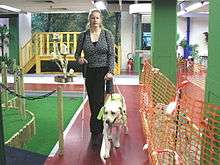
Guide, hearing, and service dogs (non-psychiatric)
A number of tasks and work a service dog might do to assist individuals with vision, hearing, mobility, or other disabilities, as compiled and published by Joan Froling, former president of International Association of Assistance Dog Partners (IAADP), a non-profit, cross-disability advocacy group composed of individuals partnered with all types of service dogs, includes:
- indicating changes in elevation
- navigating around obstacles
- locating objects on command
- retrieving dropped items
- alerting to the sound of a doorbell or fire alarm
- carrying items
- opening and closing doors
- providing counterbalance or balance support
- steadying a partner while transferring from a wheelchair [50]
Sample questions of service dog applications
- Name, address, phone, date of birth, etc.
- Level of education completed
- Number of household members
- Do you live with children?
- Where do you live? (house, apartment dormitory, city, country, etc)
- What is your gross monthly income? Full time? Part time?
- What is your primary disability?
- Do you have time to train your dog daily?
- Are you going to have your dog professionally trained?
- Have you ever owned a dog before?
- What hours would you be away from your dog?[51]
See also
References
- ↑ Equality and Human Rights Commission. "Assistance Dogs, a Guide for All Buisneses" (PDF). Equality and Human Rights Commission. Retrieved 25 August 2018.
- ↑ Das, Swetha (19 June 2017). "How Service Dogs are Aiding The London Fire Brigade in Grenfell Tower Recovery". HuffPost. Retrieved 25 August 2018.
- ↑ "International Guide Dog Federation - History". www.igdf.org.uk. Retrieved 2018-03-23.
- ↑ Ostermeier, Mark (2010). "History of Guide Dogs Use by Veterans". Military Medicine. 178: 587–593.
- 1 2 3 4 5 6 Audrestch, Hilary (2015). "Recognizing the Value of Assistance Dogs in Society". Disability and Health Journal. 8: 469–474.
- ↑ Ostermeier, Mark (2010). "History of Guide Dog Use by Veterans". Military Medicine. 178: 587–593.
- ↑ "Part 35 Nondiscrimination on the Basis of Disability in State and Local Government Services".
- ↑ "Revised ADA Requirements: Service Animals". ada.gov.

- 1 2 3 "Revised ADA Requirements: Service Animals". www.ada.gov. Retrieved 2017-02-12.
- ↑ Ravn, Karen (July 12, 2011). "Service dogs are beyond fetching". Los Angeles Times.
- ↑ Pavlides, Merope (2008). Animal-assisted interventions for individuals with autism. London: Jessica Kingsley Publishers.
- ↑ Mader, Bonnie, Lynette A. Hart, Bonita Bergen. (1989). Social Acknowledgments for Children with Disabilities: Effects of Service Dogs. Child Development 60.6.
- ↑ "14 CFR Part 382 Nondiscrimination on the Basis of Disability in Air Travel" (PDF). Department of Transportation.
- ↑ "Fair Housing Information Sheet # 6: Right to Emotional Support Animals in 'No Pet' Housing" (PDF). Emotional Pet Support.
- ↑ Huss, Rebecca. "Canines on Campus: Companion Animals at Postsecondary Educational Institutions". Missouri Law Review.
- ↑ Hill, King, Mrachko, David, Seth, Alicia (2014). "Students With Autism, Service Dogs, and Public Schools". Journal of Disability Policy Studies.
- ↑ Von Bergen, C.W. "Emotional Support Animals, Service Animals, and Pets on Campus". Administrative Issues Journal.
- ↑ Codes of Federal Regulation implementing the ADA Retrieved on November 2, 2009.
- ↑ Fair Housing Amendments Act Retrieved on November 2, 2009.
- ↑ Air Carrier Access Act Archived December 24, 2016, at the Wayback Machine.. Air Carrier Access Act PDF. August 7, 2017
- 1 2 "Americans with Disabilities Act Questions and Answers: Service Animals". www.ada.gov. Retrieved 2017-02-12.
- ↑ ADA Business Brief: Service Animals Retrieved on November 2, 2009.
- ↑ Wilson, Turner, C.C, D.C (1997). Companion Animals in Human Health. California: SAGE Publications.
- ↑ Ennik, Liinamo, Leighton, and Van Arendonk (2006). "Suitability for Field Service in 4 Breeds of Guide Dogs". Journal of Veterinary Behavior: Clinical Applications and Research 1, no. 2: 67–74 – via WSU Libraries.
- ↑ Wakshlag, Shmalberg (2014). Nutrition for Working and Service Dogs. Veterinary Clinics of North America: Small Animal Practice. pp. 719–740.
- 1 2 Steven D. Sladkus, Jeffrey M. Schwartz & Jeffrey S. Reich. "ADA and Co-op/Condo Commercial Space – Co-op Boards". Habitat Magazine.
- 1 2 "Equal Access Under the Law; Understanding the Finer Points of ADA Compliance". The Cooperator; The Co-op and Condo Monthly.
- ↑ "Service Dogs". nyc.gov.
- 1 2 "Woman sues for 10M for being denied subway rides with dog". NY Daily News. January 4, 2009. Retrieved November 7, 2013.
- ↑ "City Transit will payout $150G to Manhattan rider over service dog harassment". New York: NY Daily News. October 4, 2013. Retrieved November 7, 2013.
- ↑ "Davie woman with banished service dog gets $300,000 condo settlement". miamiherald. Retrieved 2018-03-23.
- ↑ "Davie woman with banished service dog gets $300,000 condo settlement". Miami Herald.
- ↑ Angus Loten (October 15, 2014). "Disability Lawsuits Against Small Businesses Soar". Wall Stgreet Journal.
- ↑ "Obama administration takes sides in disability suit against Uber". San Francisco Chronicle. December 23, 2014.
- 1 2 "San Antonio veteran prevails in service-dog case". San Antonio Express-News.
- ↑ "Jury: Schlumberger should allow veteran's service dog". Victoria Advocate.
- ↑ "Lawsuit over service dog in workplace goes to trial". MRT.com.
- ↑ "Laws aim to crack down on fake service dogs". CBS News. Retrieved 2017-08-08.
- ↑ "Frequently Asked Questions about Service Animals and the ADA". www.ada.gov. Retrieved 2018-04-20.
- ↑ "These 19 states are cracking down on fake service dogs". PBS NewsHour. Retrieved 2018-06-26.
- 1 2 3 "Medical and Dental Expenses (Including the Health Coverage Tax Credit)" (PDF). Internal Revenue Service. Department of the Treasury Internal Revenue Service. December 1, 2017. Publication 502; Cat. No. 15002Q. Retrieved 2018-02-05.
- 1 2 "Can Your Dog Fetch You a Tax Deduction?". US Tax Center.
- ↑ Guide Dog or Other Service Animal Retrieved on October 18, 2012.
- ↑ Richie, Robinette, Elspeth C., Robinette J. (2012). "The Early Years". U.S. Army Medical Department Journal.
- ↑ Davis, Debi. "Papillons in Service". www.papillonclub.org. Archived from the original on 2013-02-16. Retrieved 12 February 2017.
- ↑ "Pit Bulls as Service Animals: Denver quietly changes its policy".
- ↑ "Americans with Disabilities Act Questions and Answers: Breed".
- ↑ , Retrieved April 26, 2015.
- ↑ Froling, Joan. "Froling, Joan. 16 April 2001. "Assistance Dog Tasks". Located at iaadp.org/tasks.html". iaadp.org. Retrieved 12 February 2017.
- ↑ Stiverson, Pritchett, C., N. (1996). Assistance Dog Providers in the United States. North Carolina: N.C. Service Dogs.
External links
| Look up service dog in Wiktionary, the free dictionary. |
- Service Dogs at Curlie (based on DMOZ)
- Assistance Animal State Laws - Michigan State University
- Disabilities and Medical Conditions - TSA (Transport Security Administration)
- Fraud